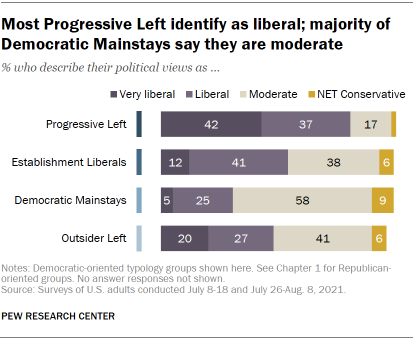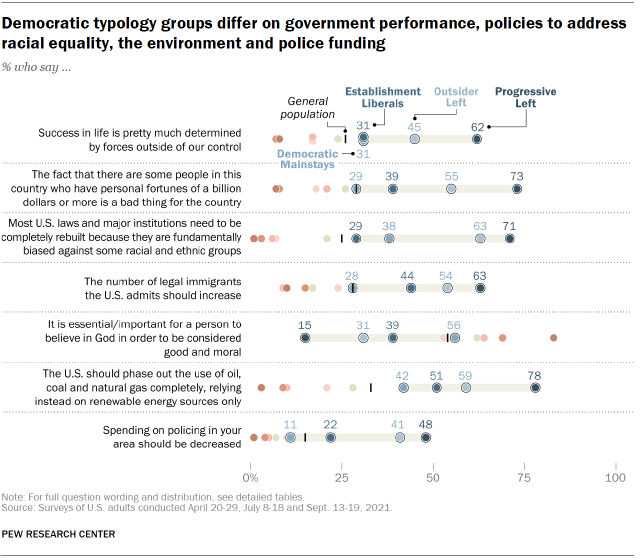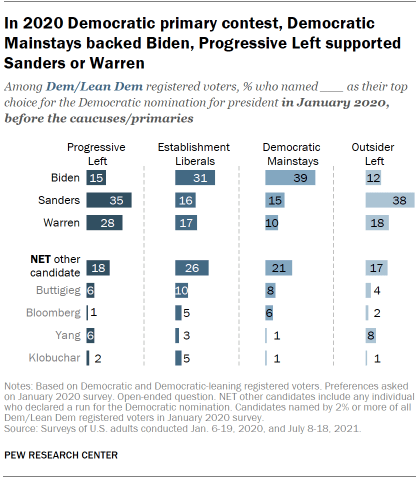As in previous political typologies, the groups that form the Democratic coalition are largely united in support for a robust role of government and a strong economic and social safety net, as well as in their skepticism about corporate power. However, there are notable differences across the coalition around views of U.S. military might and – to some extent – views related to criminal justice and immigration.
And in several key issue areas – including environmental policy, gun policy, abortion, racial equality and other topics – differences across the coalition are less about the issue itself than in the intensity of support for liberal positions and policies.
This is also the case when it comes to some aspects of economic policy. Despite sharing the beliefs that economic inequality is a problem in the country, that the economic system favors powerful interests and that government should play a role in addressing inequities, the Democratic-oriented groups differ both in their views about the magnitude of the problems and in their level of support for proposed solutions.
In several other domains, divides seen in past typologies across the Democratic-oriented groups – particularly over social issues – are now areas where there is generally more agreement among Democrats than in the GOP coalition.
In part because some issues that used to divide the Democratic Party – like same-sex marriage, abortion and marijuana legalization – are no longer major fault lines, cleavages on the left flank of the party are now more evident. And, for the first time, this year’s political typology identifies not just a single solid liberal group, but distinctions across several liberal groups.
The most liberal group – nearly 80% call themselves liberal, including 42% who describe themselves as “very liberal” – Progressive Left make up a relatively small share of the party, 12% of Democrats and Democratic-leaning independents. However, this group is the most politically engaged segment of the coalition, extremely liberal in every policy domain and, notably, 68% White non-Hispanic. In contrast, the three other Democratic-oriented groups are no more than about half White non-Hispanic.
Establishment Liberals, who make up a significantly larger share of the party (23%) than Progressive Left, also vote at high rates and are very politically attentive.
But while Establishment Liberals have liberal opinions on nearly all issues, they tend to support more measured policy approaches and are more likely to back political compromise than Progressive Left and, to some extent, Outsider Left.
For instance, while all Democratic groups say by wide margins that more needs to be done to ensure equal rights for all Americans, regardless of their racial or ethnic backgrounds, Establishment Liberals are somewhat more likely than other groups to say needed changes can be made within existing laws and institutions. A majority also say the party should be at least somewhat accepting of members who sometimes agree with the GOP on issues.
Democratic Mainstays – the largest single group in the Democratic coalition this year (constituting 28% of Democrats and Democratic leaners) – are considerably more likely than other groups to call themselves politically moderate. Still, they hold nearly as liberal positions as other Democratic-oriented groups on economic issues, while they diverge from others in the coalition somewhat on immigration issues. (For instance, they are much less likely to support increasing legal immigration and more likely to identify illegal immigration as a problem in the country.) They also are more invested in U.S. military power than other Democratic-oriented groups. Black Democrats are particularly concentrated in this group: 40% of Black Democrats are Democratic Mainstays. Mainstays are also older and less likely to be college educated than other segments of the coalition.
Outsider Left – 16% of Democrats and Democratic leaners – are young, progressive and not particularly at ease within the Democratic Party. Though they are not quite as liberal across the board as Progressive Left and express some skepticism about government performance, their liberalism is particularly evident when it comes to race, immigration and environmental issues.
While Outsider Left are more likely to identify as political independents than as partisans – and nearly nine-in ten (86%) say that they usually don’t feel like there are political candidates that represent their views well – their dissatisfaction with the party largely comes from a liberal, not moderate, perspective.
Outsider Left are not as reliable voters as other Democratic-oriented groups, but when they do vote and are faced with a choice between GOP and Democratic candidates, they overwhelmingly cast their votes for Democrats.
Stressed Sideliners, despite not having a clear partisan tilt, make up small but significant shares of both the Democratic and Republican coalitions (13% of Democrats and Democratic leaners, 15% of Republicans and Republican leaners). This group is financially stressed and relatively unengaged with politics. They generally have attitudes that place them near the center of overall public opinion, tilting more liberal than conservative on economic issues, while tilting more conservative on some social issues. And while they vote at significantly lower rates than other typology groups, 45% of them cast ballots in 2020 – roughly half of them voting for Joe Biden.
An additional 8% of Democrats and Democratic leaners belong to a GOP-oriented typology group (the majority of whom are part of Ambivalent Right). These are individuals who lean Democratic, but whose values and attitudes are more aligned with a group whose other members tend to be affiliated with the GOP. (Similarly, 6% of Republicans and Republican leaners belong to Democratic-oriented typology groups.)
Areas of general agreement within the Democratic coalition
Three-quarters or more of those in all four core Democratic-oriented typology groups say government should do more to solve problems. There is even more widespread agreement within the coalition that the economic system unfairly favors powerful interests and that tax rates on large businesses and corporations – and on households with incomes over $400,000 – should be raised, as should the federal minimum wage.
On questions of racial equity in society, Democratic-oriented groups also generally share a sense that more needs to be done in the country to achieve racial equality, that White people benefit from advantages in society that Black people do not, and that Black, Asian and Hispanic people face at least some discrimination in society.
About three-quarters or more in all four groups also say that women continue to face significant obstacles in society that make it harder for them to get ahead than men.
The coalition is largely united on key issues related to voting rights and access. Wide majorities say voting is a fundamental right that cannot be restricted; about three-quarters or more favor several reforms like making Election Day a national holiday, automatic voter registration, allowing convicted felons to vote after serving their sentences and expanding early voting. Note: For full question wording and distribution on each question, see detailed tables.
Divides within the Democratic coalition
Despite largely agreeing on key economic attitudes, there are areas where aspects of the Democratic coalition diverge. Progressive Left stand out as the only typology group in which a majority say that “success in life is pretty much determined by forces beyond our control” (rather than that “everyone has it in their own power to succeed”). And while 73% of Progressive Left say the fact that there are billionaires in this country is bad for the country, as do 55% of Outsider Left, most Democratic Mainstays and Establishment Liberals do not share this view.
Although majorities across all Democratic-oriented groups say more needs to be done to address racial inequities in society, the groups differ on how to achieve needed change. Clear majorities of Progressive Left (71%) and Outsider Left (63%) say change will require completely rebuilding most U.S. laws and institutions because they are fundamentally biased against some racial and ethnic groups, while far smaller shares of Democratic Mainstays (38%) and Establishment Liberals (29%) say this.
Democratic-oriented groups also differ over the extent to which they see immigration as a good, with Democratic Mainstays, in particular, offering somewhat more conservative views. For example, while 63% of Progressive Left and 54% of Outsider Left say the U.S. should admit more legal immigrants, that drops to 44% of Establishment Liberals and 28% of Democratic Mainstays (most say the number of legal immigrants should stay about the same).
Democratic-oriented groups are largely united in saying that climate change is a big problem for the country, that stricter environmental laws are worth the cost and that the priority for energy investment should be on developing alternative sources – like wind, solar and hydrogen. But differences emerge when it comes to the intensity of these views. Nearly eight-in-ten Progressive Left (78%) say that the U.S. should phase out the use of oil, coal and natural gas entirely, a position taken by a narrower majority of Outsider Left (59%), along with about half of Establishment Liberals (51%). By contrast, a smaller share (42%) of Democratic Mainstays hold this view, while a narrow majority (55%) say instead that the country should use a mix of energy sources, including fossil fuels.
Nearly half of Progressive Left (48%) say police funding in their area should be decreased, as do 41% of Outsider Left. But both Democratic Mainstays and Establishment Liberals reject this idea. In fact, both groups are more likely to say that police funding in their areas should be increased than to say it should be decreased: 47% of Democratic Mainstays say police funding should be increased, while just 11% say it should be decreased. Among Establishment Liberals, 31% say it should be increased, 22% say it should be decreased and 47% say it should stay the same.
The Democratic-oriented groups: Voting and views of the presidents
In the 2020 election, Joe Biden garnered the vast majority of votes cast by those in all four of the Democratic-oriented groups. Among 2020 voters, 92% of Democratic Mainstays and 94% of Outsider Left voted for Biden – as did nearly all Establishment Liberals and Progressive Left (98% each). But some groups were more likely to turn out than others. Fully 86% of Progressive Left and 78% of Establishment Liberals have a record of having voted in 2020, while that drops to 68% among Democratic Mainstays and to 57% among Outsider Left. And although a majority of Stressed Sideliners did not vote, those who did were about evenly split between Biden and Donald Trump in their votes (48% vs. 49%, respectively).
Similar patterns are evident in vote intention for the 2022 midterm elections. While overwhelming majorities of registered voters in all four Democratic-oriented groups say they would vote for a Democratic House candidate over a Republican candidate, Outsider Left are far less likely than others to say that control of Congress “really matters” – and they are somewhat more likely than other groups to say, when faced with the choice of a Democrat or a Republican for their House seat, they’d opt for “another candidate” (8%) or say they are not sure (17%).
While Biden won the votes of overwhelming majorities of those in all Democratic-oriented groups who voted in 2020, some groups feel more positively than others about the president. Asked to rate Biden on a “feeling thermometer” where 0 is the coldest rating and 100 is the warmest, Establishment Liberals offer an average rating of 79, or very warm, while Democratic Mainstays’ average rating of Biden is a similarly very warm 77. Progressive Left also rate the president warmly, though somewhat less so (average 72), while Biden averages a lukewarm 56 degree rating among Outsider Left.
Yet ratings of Biden’s 2020 general election opponent among these groups are more uniform. Trump’s rating tops out at a very cold average 14 degrees among Outsider Left and is a frigid 2 degrees among Progressive Left.
Majorities in all Democratic-oriented typology groups point to Barack Obama as the best president of the last 40 years. Progressive Left (72%) and Establishment Liberals (66%) are particularly likely to say this. While a 54% majority of Democratic Mainstays name Obama, 22% of this group name Bill Clinton, a higher share saying this than among Progressive Left (14%) and Establishment Liberals (17%).
The 2020 Democratic primary through the lens of the typology groups
Looking back to the 2020 Democratic presidential primary contest, the Democratic-oriented typology groups had distinctly different preferences heading into the first caucuses and primaries. In January 2020, when there were still about a dozen Democratic candidates in the running, 39% of Democratic Mainstays named Biden as their first choice for the nomination, more than twice as many as named any other single candidate. Biden also held an edge among Establishment Liberals, though about a quarter of this group (26%) named candidates with less overall support (then-Mayor Pete Buttigieg, Sen. Amy Klobuchar, Michael Bloomberg and others).
By comparison, Sen. Bernie Sanders had the support of 35% of Progressive Left, with this group nearly as likely to name Sen. Elizabeth Warren (28%) as their first choice – and a far smaller share (15%) naming Biden. And while Outsider Left were similar to their Progressive Left co-partisans in their support for Sanders (38% named him), they were less likely to back Warren (18%).
Who should be allowed in the Democratic Party tent?
Although a majority of Democrats and Democratic leaners say the Democratic Party should be generally accepting of elected officials who are openly critical of Biden, that sentiment differs across Democrats within typology groups: While just 25% of Progressive Left and 30% of Outsider Left say the party should not be accepting of those who are critical of the president, that rises to 42% among Democrats who are Establishment Liberals and 55% of those who are Democratic Mainstays.
Progressive Left, by contrast, are more likely to say the party should not be accepting of members who agree with the Republican Party on some issues (41% say this, as do 38% of Democratic Mainstays, while just 29% of Establishment Liberals and 27% of Outsider Left say the same).
And while majorities of Democrats who are Establishment Liberals (59%), Democratic Mainstays (55%) and Outsider Left (57%) say the Democratic Party should not be accepting of elected officials who call GOP elected officials “evil,” that drops to 42% among Progressive Left.
The ‘democratic socialist’ label
Today, Progressive Left are the only typology group in which a majority say they like political leaders who identify as democratic socialists – 60% say this, while just 4% say they do not. Both Establishment Liberals and Outsider Left are more likely to say they like this about a political candidate than to say they dislike it; still, about half of those in these groups say they neither like nor dislike candidates who use this self-description.
Democratic Mainstays are the least likely to say this label appeals to them – just 23% say it does, the same share who say they dislike the label. About half (52%) say they neither like nor dislike it.
Race and ethnicity, age and the Democratic coalition
Democratic Mainstays make up 28% of the Democratic coalition – the largest single group. But they are an even larger share of Black Democrats: Four-in-ten Black Democrats are Democratic Mainstays. By comparison, the share of Black Democrats who are Establishment Liberals is nearly identical to the overall share of Democrats who fall into this group. And just 12% of Black Democrats are Outsider Left, while only 6% are Progressive Left, in both cases substantially smaller shares than in the overall Democratic population.
Hispanic Democrats also are somewhat less likely than Democrats as a whole to be Progressive Left (just 7% of Hispanic Democrats are Progressive Left). However, 19% are Outsider Left. Hispanic Democrats are somewhat more likely than Democrats in other racial and ethnic groups to fall into GOP-oriented political typology groups.
Roughly a third of Asian American Democrats (32%) are Establishment Liberals – a larger share of Asian Democrats belong to this group than among White, Black and Hispanic Democrats. Asian American Democrats are also more likely than White and Black Democrats to be Outsider Left – roughly a quarter fit into this group (24%). And Asian American Democrats are far less likely than Democrats as a whole to be Democratic Mainstays – just 19% are in this group.
A quarter of White Democrats are Democratic Mainstays, while a similar share (24%) are Establishment Liberals, 16% are Outsider Left and 15% are Progressive Left – a larger share than among Black or Hispanic Democrats.
Older Democrats are far more likely than younger Democrats to be Democratic Mainstays: 42% of those ages 65 and older and 37% of those 50 to 64 belong to this group. By comparison, just 15% of Democrats under age 30 and 23% of those 30 to 49 are Mainstays.
In contrast, the largest single group among Democrats ages 18 to 29 is Outsider Left, with three-in-ten falling into this group. The youngest Democrats are also more likely than older Democrats to be Progressive Left.


















